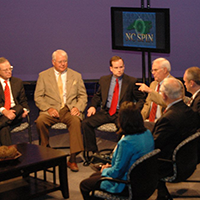Germans played role in Carolina revolt
Published August 14, 2025
By John Hood
As Americans continue to celebrate our country’s semiquincentennial — the 250th anniversary of the Declaration of Independence and the war for American independence — I will continue to highlight the pivotal role that North Carolinians played in these historic events.
Some are household names, at least within our state, while others are remembered primarily by historians, hobbyists, and their own descendants. Some were born in North Carolina, some were brought here in chains, and others emigrated here in search of freedom and opportunity.
Among the latter was Frederick Hambright, born in the Duchy of Bavaria in 1727. When Frederick was 11 years old, the Hambrights joined what had by that time already become a flood of German-speaking immigrants who typically landed in Philadelphia, lived in Pennsylvania for a generation or so, and then headed south along the Great Wagon Road to settle in the Virginia or Carolina backcountry. It is estimated that by the eve of the Revolutionary War, as much as 30% of North Carolina’s population was German.
Frederick Hambright followed the pattern precisely. When he turned 18, Hambright left Pennsylvania for Henrico County, Virginia, where he married and fathered the first of a dozen children. In 1760, he and his family relocated with several in-laws and friends to western North Carolina, settling near the banks of the Catawba River.
Today, the site is in Gaston County. During the Revolutionary period, however, it lay in Tryon County, which sprawled across all or parts of present-day Gaston, Cleveland, Lincoln, Rutherford, Burke, and McDowell counties, plus some communities in upstate South Carolina (frontier boundaries were fuzzier then).
I tell you that because Frederick Hambright first enters the history books as a member of the Tryon Committee of Safety. Like their counterparts in other frontier communities, leaders in Tryon County read with alarm accounts of the British army attempting to suppress the unruly colonists of Massachusetts. When news of the battles of Lexington and Concord reached the backcountry in the late spring of 1775, county committees of safety began issuing resolutions of support for their fellow Americans and opposition to British tyranny.
Mecklenburg went first, on May 20 — a date still commemorated on North Carolina’s flag. Committees in Wilmington, New Bern, Fayetteville, and elsewhere soon followed suit. On Aug. 14, 1775, Hambright and 48 other leaders met at the county courthouse to draft the “Tryon Declaration of Rights and Independence from British Tyranny.” Issued 250 years ago this week, it’s now called the Tryon Resolves.
Deploring the “unprecedented, barbarous and bloody actions committed by British troops,” the signers recognized the “painful necessity of having recourse to arms in defense of our national freedom and constitutional rights.” Not only did the self-described “subscribers” pledge to “risk our lives and our fortunes in maintaining the freedom of our country,” but they also agreed to “hold all such persons as inimical to the liberties of America who shall refuse to sign this association.”
Strong words, to be sure, but Tryon County’s patriots soon backed them up with strong action. Foremost among them was Frederick Hambright. Within days of signing the resolution, he traveled east to Hillsborough to represent the county at the Third Provincial Congress, which organized an independent government for North Carolina and readied its people for war.
Upon returning home, he became an officer in the Tryon County militia and led a company during the 1776 campaign against British-allied Cherokees. By 1780, he was Lieutenant Colonel Frederick Hambright, commanding American forces at the battles of Ramseur’s Mill (June 20) and Kings Mountain (Oct. 7), where he suffered a musket wound to the thigh.
Hambright “knew he was wounded,” said an eyewitness, but insisted “he could still ride very well and therefore deemed it his duty to fight on till the battle was over.” He walked with a limp the rest of his life — but his family, friends, and fellow North Carolinians needed no such reminder of Frederick Hambright’s heroic service.
Nor should we.
John Hood is a John Locke Foundation board member. His books Mountain Folk, Forest Folk, and Water Folk combine epic fantasy and American history.







